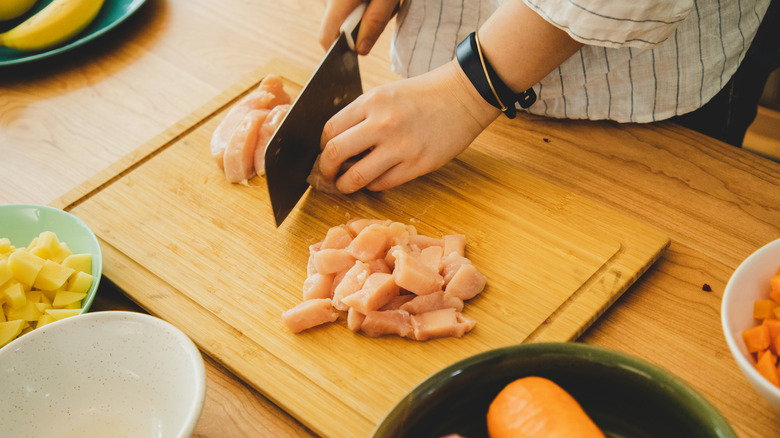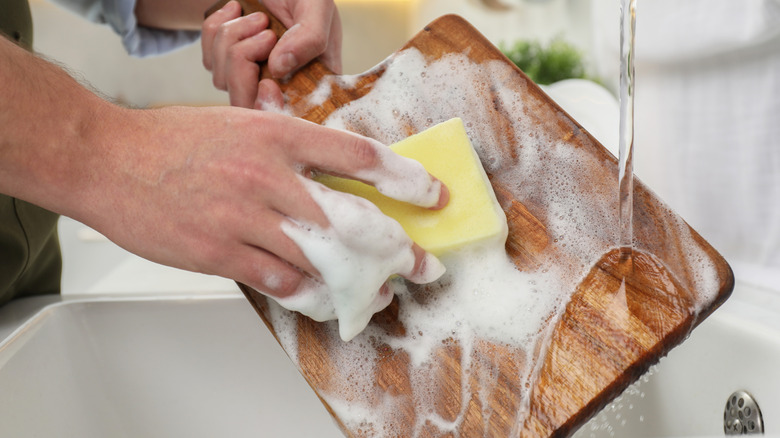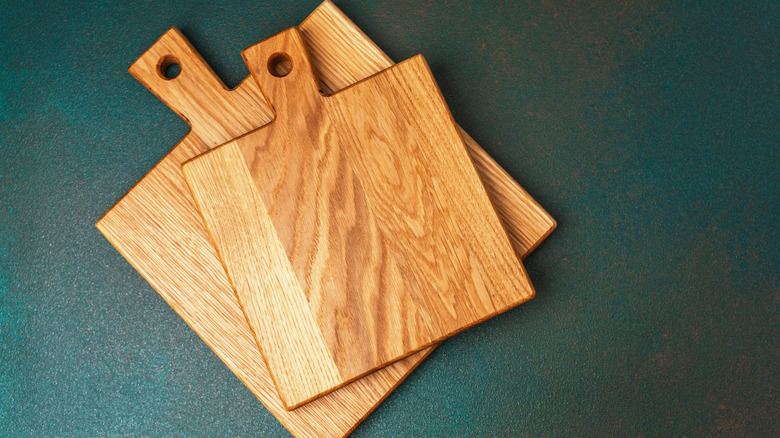Your Cutting Board Might Be Dirtier Than Your Toilet
From the time we were kids, we were taught that germs are everywhere. However, while they may be ubiquitous, some places have them in far greater numbers than others. When talking about our homes, it's easy to assume that the toilet harbors the most microbes, since it's where we conduct our personal business. But you may be surprised that your trusty cutting board in the kitchen actually holds way more germs than your toilet.
In an interview with CNN, microbiologist Charles Gerba, also known as "Dr. Germ," says our toilets may actually be cleaner than our cutting boards. "Recent surveys of homes found more fecal bacteria on a cutting board in the average home than a toilet seat," he said, adding, "It's actually safer to make your sandwich on a toilet seat than a cutting board."
Cutting boards are among the must-have items in every home kitchen. After all, almost every type of meal prep requires cutting, slicing, and chopping ingredients in one way or another. However, the sad reality is that we often clean our toilets more thoroughly than our cutting boards. Sure, we wash them after every use, but we don't really pay attention to how clean they should be.
We also tend to use only one board for slicing everything — from raw meats to seafood and vegetables. Thus, while our toilets get a weekly bleach treatment, our cutting boards might be a quiet breeding ground for disease-causing germs.
How to properly clean your cutting board so it doesn't become a biohazard
A swab analysis of 30 common household items conducted by NSF International found that 18% of cutting boards are contaminated with bacteria such as E. coli and Salmonella, which are responsible for gastrointestinal illnesses. To avoid turning this kitchen utensil into a petri dish of sorts, you should learn how to clean cutting boards properly. Experts like Gerba strongly recommend using a bleach solution — either from a cleaning product that contains bleach or a homemade mixture of one tablespoon of bleach diluted in one gallon of water.
As for frequency, Gerba didn't really say how often this should be done, but it's safe to assume that you should do it frequently, especially after using the cutting board to cut raw meat, poultry, or seafood. Regular disinfection with bleach will not only reduce the inconspicuous bacteria lurking in your cutting board, but it can also prevent cross-contamination. It can even help preserve the life of your kitchen tool because, yes, even though cutting boards don't have an expiry date, there will come a point when you have to throw them out.
Aside from your cutting board, you also need to disinfect your other kitchen tools to really lower the risk of cross-contamination. The National Sanitation Foundation (NSF) recommends using the same weak bleach solution to sanitize drains, countertops, and disposals. Replacing sponges weekly and wiping down faucet and fridge handles are also advised.
Why you need more than one cutting board in the kitchen
As mentioned earlier, cutting boards can be a source of cross-contamination. So, if you are still relying on a single cutting board for all your slicing and chopping activities in the kitchen, it's time to change that. According to the USDA's Food Safety and Inspection Service (FSIS), it's best to have one cutting board for bread, fruits, and vegetables, and a separate board for raw meat, poultry, and seafood. This way, you can lower the chances of bacteria from meat and meat products contaminating non-meat ingredients that often do not require cooking.
Now, regarding the type of cutting board to use for meat, there really isn't a strict guideline to follow. The FSIS only says nonporous types, such as plastic, are easier to clean than those with porous surfaces, like wood. However, it can be assumed that plastic cutting boards are better for use when chopping poultry and other meats because bacteria wouldn't be able to hide in their nonporous surface. They're also easier to maintain since you can have them cleaned via the dishwasher. On the other hand, wooden types require manual scrubbing, drying, and even periodic oiling and waxing to prevent cracking and warping.
Nevertheless, plastic cutting boards are not without issues. Some experts don't recommend them because they can be a source of microplastics, which is another health hazard. Cutting boards made of glass, stone, titanium, and natural rubber are generally considered better options.


